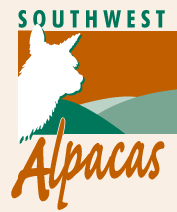| |
|
-
by Jacquie Watson
 “The more you learn, the more there is to learn”. We have discovered the fundamental truth of this saying over the last decade. When we bought our first alpacas nearly a decade ago, not only did we know very little about the care and breeding of these lovable animals, but (we now realize in retrospect) the few established breeders at the time were still feeling their way. The US and Australia already had large established herds – in the UK, the animal was still something of a novelty. “The more you learn, the more there is to learn”. We have discovered the fundamental truth of this saying over the last decade. When we bought our first alpacas nearly a decade ago, not only did we know very little about the care and breeding of these lovable animals, but (we now realize in retrospect) the few established breeders at the time were still feeling their way. The US and Australia already had large established herds – in the UK, the animal was still something of a novelty.
A great deal of the advice that was offered at the time turned out, in the light of our subsequent experience, to be nearer to folk wisdom than scientific truth. For example, “You must re-mate the females within 2- 3 weeks of birthing or you’ll struggle to get them pregnant”; “Make sure you separate out the cria for weaning by the time they’re 6 months old”; and “It’s no use giving them a field shelter – they won’t use it”.
Like most folk tales there was a grain of truth in each of these statements, but as a guide to building a happy and healthy herd, they turned out to be more hindrance than help. Unlike us, you don’t have to learn the hard way! This article summarizes what we tell people who want to build a herd with the fewest problems and least stress – for both owners and animals. It also assumes that whilst commercial considerations are important, the welfare of the animals is the primary concern. I well remember explaining one or two of our ideas some years ago to a new owner who pointed out that this was just not an acceptable approach as it would negatively impact her spreadsheet projections . . .
One idea that came to us at the beginning of our journey of alpaca discovery certainly turned out to be well founded, and has indeed guided us successfully over the years. “Look after the herd, rather than the animal”. For want of a better word, we named this the holistic approach to husbandry. We started out with 4 animals, and have built up the herd over the last few years to run between 20 and 40. Now it may be that our animals are healthy and happy in spite of our bumbling efforts– we can only judge from our rather limited experience of a single herd managed on a single site over nine years or so. However, we can claim that over this period we’ve never had a single fatality amongst the animals bred and reared on our property.
Unlike most stock, particularly sheep, we have discovered it’s possible to keep alpacas healthy primarily with good herd management. So where we do have problems, we generally assume that it is our husbandry at fault. This also leaves us with one or two “blind spots”. We get a couple of calls a year from new alpaca owners who ask us “We have a cria whose mum has died/rejected/no-milk – how do we go about bottle-feeding?” We’re not much help as it’s never happened to us so we’ve never had to do it.
|
|
|
Holistic Husbandry
This holistic approach doesn’t mean they never fall ill – several years ago, we had 3 cases of jaw abscess over a 2 year period. We stopped feeding dry chopped alfalfa and we’ve not had a case since. A year ago we had a few girls whose pregnancies had slipped over the winter; then a couple of the older cria developed limb weakness and listlessness. This turned out to be due to selenium deficiency, which was a puzzle as there had been no significant change in the forage or supplements compared to previous years. We’re still trying to work that one out.
This holistic approach is based around a simple methodology – to minimise all stress factors on the herd. There are very many possible stress factors, so it helps to categorise into three groups:
- Environmental
- Nutritional
- Social
Environmental Stress
Let’s start with the most obvious and the easiest to deal with. If your animals have to endure prolonged periods being cold and wet, some of them may die, especially the cria. Now this doesn’t need a methodology, just plain common sense, particularly in our cold, wet and windy UK winters. Yet we know of a farm running alpacas on low lying land prone to flooding with no field shelters. They also send their animals off-site for mating, which is another major stress factor in our estimation. And still they wonder why they have several fatalities each year.
 Winter cria are also a bad idea, both because of the poor UK weather, and the lack of good grazing for the milking mums. Since we started out, we have plotted the weekly weight gain of all our cria. We found that the spring/early summer cria typically gained weight at more than twice the rate of the autumn/winter cria. We quickly confined our pregnancies to April though August. Any animals that weren’t pregnant to this schedule we held over. And this led us to the discovery that in fact there’s no problem with getting them in cria even after several months away from the stud. Winter cria are also a bad idea, both because of the poor UK weather, and the lack of good grazing for the milking mums. Since we started out, we have plotted the weekly weight gain of all our cria. We found that the spring/early summer cria typically gained weight at more than twice the rate of the autumn/winter cria. We quickly confined our pregnancies to April though August. Any animals that weren’t pregnant to this schedule we held over. And this led us to the discovery that in fact there’s no problem with getting them in cria even after several months away from the stud.
Incidentally, low stress is one of the important factors in achieving and holding a pregnancy. For example, we aim for shearing to take place as early as possible in the season, so that the stress caused doesn’t impact on breeding success. In any case, we would never shear a female within 45 days after mating.
Parasites, particularly intestinal worms, are another issue. We don’t worm our animals on a regular basis. It seems to work for us – your experience may vary. If you have a very large herd, or a regular turnover in your stock with animals coming and going, or limited pasture for your herd size – then you probably should be worming your animals. We have the luxury of 25 acres of grazing for our animals, which we rotate on a regular basis. We also maintain a couple of clean maternity paddocks reserved exclusively for expectant mums.
 As a result, the combination of low worm burden and low stress seems to keep any worm problems at bay. Indeed, we would claim – without any supporting evidence, however – that “unprotected” exposure to a low worm burden allows the cria to develop their natural immunity. In any case, we have never had a clearly identified problem with worms in any of our animals. As a result, the combination of low worm burden and low stress seems to keep any worm problems at bay. Indeed, we would claim – without any supporting evidence, however – that “unprotected” exposure to a low worm burden allows the cria to develop their natural immunity. In any case, we have never had a clearly identified problem with worms in any of our animals.
This doesn’t mean the worm problem can be ignored, and we test faecal samples on a regular basis. We’re also participating in a new UK study on worm infestation in alpacas organised by the Royal Veterinary College, so it will be interesting to see what this reveals.
|
Nutritional Stress
Obviously, if you don’t feed you animals properly, they’ll fail to
thrive. Coming from a high altitude semi-desert volcanic plateau on the other side of the world, it’s not surprising that they don’t immediately adapt to the lush, wet and poorly mineralised forage (compared to their native conditions) that they encounter in the UK. Our sheep, cattle and horses have evolved to take best advantage of these conditions - alpacas still have to make the transition. This has a number of implications, but two are the most important:
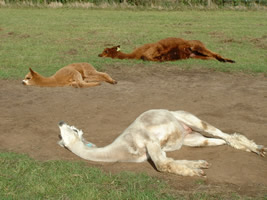 High mineral requirement – this can only be achieved by adequate supplementary feed. However, the level of mineralization in your pasture will very probably differ from ours, and it is not within the scope of this article to go into great detail on this subject. Briefly, try to identify what are the major mineral deficiencies in your locality and in your pastures, and make sure that you are correcting for this. Secondly, choose a supplemental feed with a high mineral content – “calf-mix” simply will not do. There are a number available, but unfortunately, some are formulated in such a way as to impact negatively on the second issue (see below). High mineral requirement – this can only be achieved by adequate supplementary feed. However, the level of mineralization in your pasture will very probably differ from ours, and it is not within the scope of this article to go into great detail on this subject. Briefly, try to identify what are the major mineral deficiencies in your locality and in your pastures, and make sure that you are correcting for this. Secondly, choose a supplemental feed with a high mineral content – “calf-mix” simply will not do. There are a number available, but unfortunately, some are formulated in such a way as to impact negatively on the second issue (see below).
Highly efficient digestive system - highly-efficient, but also highly sensitive to the composition of the feed, and to changes in that composition. The most important component is fibre – and lots of it. Also, if the digestive balance is upset, then the highly efficient extraction of nutrients goes into reverse, and malnutrition can ensue. Perversely, one way to upset this balance is by feeding a diet which is too rich – particularly in starch and/or sugars. For example, many of the commonly available supplements contain corn (too starchy) and molasses (high sugar, which they love, and will overeat if they can).
Dealing with these two issues should always be driven by the results of condition-scoring your animals on a regular basis. Another simple test is to check what comes out the other end. Firm dark pellets? Good. Anything lighter or sloppier? Check for feeding problems if it persists. And worms, of course.
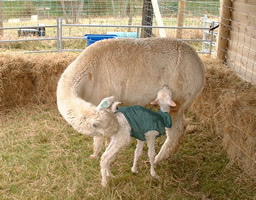 If condition is low, how do you fix the problem? Simply shovelling more food in may not be very effective – indeed if this upsets the digestive balance, it may make it worse. First of all make sure that your diet is properly balanced, particularly for the older girls. Secondly, if you’re planning to change or increase the feed intake of individual animals, the key thing to remember is – do it slowly. A sudden increase in quantity or an abrupt switch from one supplement formulation to another may have a negative impact, at least in the short term. If condition is low, how do you fix the problem? Simply shovelling more food in may not be very effective – indeed if this upsets the digestive balance, it may make it worse. First of all make sure that your diet is properly balanced, particularly for the older girls. Secondly, if you’re planning to change or increase the feed intake of individual animals, the key thing to remember is – do it slowly. A sudden increase in quantity or an abrupt switch from one supplement formulation to another may have a negative impact, at least in the short term.
Another more obvious form of stress is feeding time. We use individual feeders well spaced out in covered feeding stations, not troughs in the field. These feeding stations also provide access to dry hay and shelter. Dumping feed into troughs causes a high level of stressful squabbling, and the more dominant animals will get the lion’s share, particularly of that tasty molassed feed. One dominant female many years ago would gorge until she went off to perform projectile vomiting. And needless to say, we had a problem with her condition! |
Social Stress
Unlike the two stress factors listed above, most of which are well documented elsewhere, “social stress” factors seems to get much less attention. So here we are working much more from our own personal observation and experience. The alpaca is a prey animal that looks to the herd for protection. The females in particular appear to have a complex social organisation – unlike the (non-working) boys, who just seem to “hang out” together in a much more informal group.
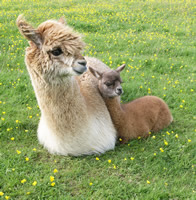 We try, to the greatest extent possible, to encourage the development and stability of this social group, as it appears to be a major source of stress - and consequent problems - when it’s not working well. The most obvious sign of a stressed herd is regular squabbling between animals. Impaired condition, increased disease susceptibility and poor mothering, weak & underweight cria may be more serious symptoms, though less immediately obvious as a consequence of stress. We try, to the greatest extent possible, to encourage the development and stability of this social group, as it appears to be a major source of stress - and consequent problems - when it’s not working well. The most obvious sign of a stressed herd is regular squabbling between animals. Impaired condition, increased disease susceptibility and poor mothering, weak & underweight cria may be more serious symptoms, though less immediately obvious as a consequence of stress.
How can you encourage this happy state of affairs? To some extent, it depends on your starting point. If you’re just embarking on alpaca ownership, then you have the easiest task. If you already have a fully commercial operation running several hundred animals, I wouldn’t have a clue what to tell you. So what follows is aimed at the small to medium size breeder, not for the bigger guys.
When starting out, the initial herd setup is of major importance. You’ll need a minimum of four animals, of which at least one should be significantly older. “Granny” becomes the herd leader –the alpha female – and the others find their places in the hierarchy accordingly. Six would be better, with an “Auntie” or two. If they’re all the same age, there will be much more dispute over who’s boss, which will in any case change more frequently.
Secondly, breeding age. It is commonly recommended that a female is ready for breeding once a minimum weight has been reached – and this can be as early as one year old.
I suspect this is a rule which works on the Peruvian Altiplano, where it probably takes considerably longer to achieve a viable breeding weight – but we believe is inappropriate for the different conditions we find in the UK. Our rule of thumb is therefore a minimum of eighteen months to allow full development of social and parenting skills. It is quite amazing to watch how, if given the space and time, the young females learn parenting skills by helping the new mums with their cria. Granny and Auntie help out too. This seems to be a natural learning process, and we believe it is a significant factor in breeding success.
When coupled with our practice of mating only in the Spring/Summer months, our initial breeding age works out more typically nearer two years in practice. So our females will be approaching three years old before they drops their first cria. It was at this point that the aforementioned lady suffered acute spreadsheet shock. But if you want to take a hard-nosed view on this, then try to factor in the cost of dead or rejected cria – not to mention the grief. Now in our eighth year of cria births, we have never had (discounting two with severe genetic malformations) a dead or rejected cria. So all I can say is either we’re very lucky – which is possible, and this coming year will be a stinker – or our approach seems to work.
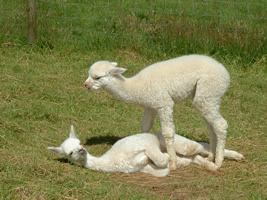 Next is weaning. Our basic advice is - don’t. We leave the female cria in with the herd - forever. Their mums, if pregnant, go into the nursery paddock about 4-6 weeks before birthing, leaving their offspring behind. They hardly notice. In any case, the mums have generally weaned their cria naturally by then. We separate out the boys, in a single group, at around 8 months or so, but only because by this time they are big enough to start pestering the girls to practise their mating skills. The boys may indeed find this process a little stressful at first, but they’re not the one’s doing the breeding – so tough! Next is weaning. Our basic advice is - don’t. We leave the female cria in with the herd - forever. Their mums, if pregnant, go into the nursery paddock about 4-6 weeks before birthing, leaving their offspring behind. They hardly notice. In any case, the mums have generally weaned their cria naturally by then. We separate out the boys, in a single group, at around 8 months or so, but only because by this time they are big enough to start pestering the girls to practise their mating skills. The boys may indeed find this process a little stressful at first, but they’re not the one’s doing the breeding – so tough!
Lastly – don’t send your females away off-site for mating. I know it is more trouble and expense to get the boy to the farm, but look at it from the girl’s point of view. Often with a very young cria at foot, she’s shipped off to a strange herd, having to fight for a new position and almost certainly the feed changes dramatically. You could probably go through this article and identify almost every stress factor listed. Three months later she’s shipped back – hopefully pregnant – and has to re-integrate into the old herd, diet changes again, etc. This is no way to treat a lady, or her offspring, and certainly doesn’t make for a happy & healthy alpaca. |
| |
last
updated
May 20, 2009
|
|
|
